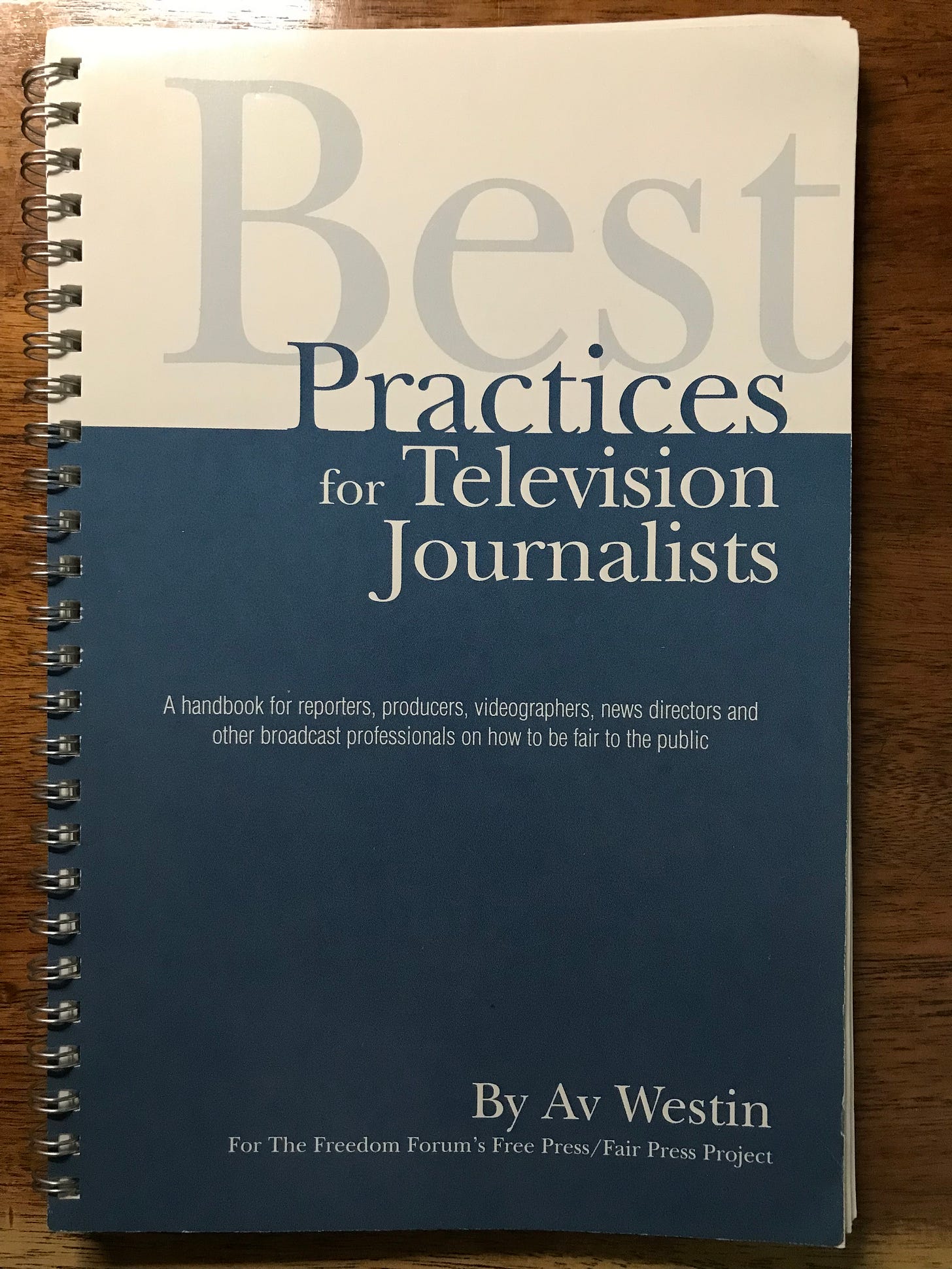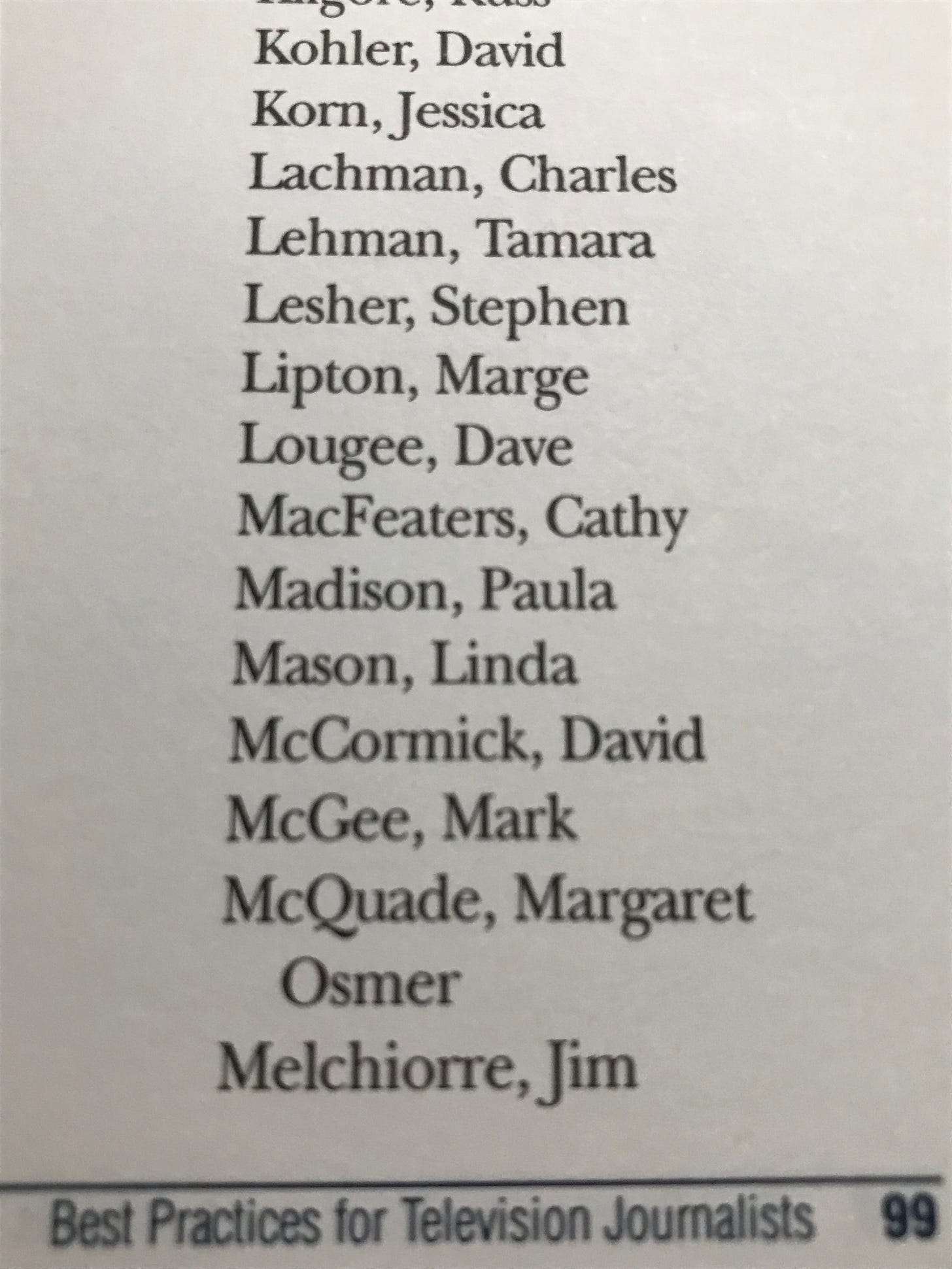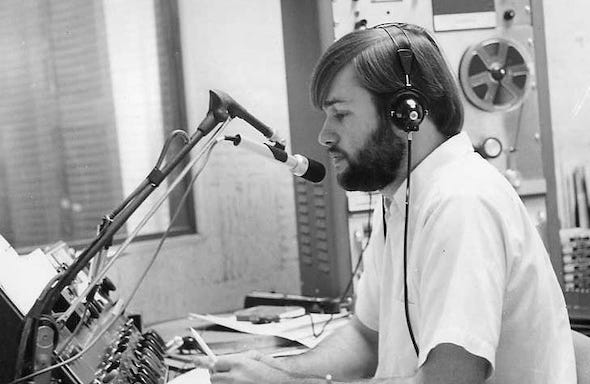I was privileged to participate in a special project 25 years ago with The Freedom Forum’s Free Press/Fair Press Project. It led to the publication of Best Practices for Television Journalists in January of 2000. You can see my name in the Appendix List of participants on page 99 —
Before I get into some of the specifics about how I and other journalists responded to The Freedom Forum, here’s some background to who wrote the book and why.
Author and Findings
The author of the book, Av Westin, passed away in 2022 at the age of 92. Westin began his broadcast journalism career at CBS News in 1949. He later became the executive producer of ABC Evening News, and also served ABC as vice president and director of television documentaries and program development. The Freedom Forum chose Westin to author the book. It was based on the Forum’s research with members of the public and with local and network news executives.
As Westin wrote in his ‘Executive Summary’ about the journalists who participated in the project —
There is no direct attribution in this handbook, an arrangement that assured maximum candor from each of the television news executives and journalists we interviewed. This reflects a standard practice on television news programs in which the subject’s identity is disguised or hidden to enable important and revealing information to be broadcast without putting life or livelihood at risk. The names of the individuals interviewed for best practices as well as sound bites are listed in the Appendix. p 7
Robert Giles, senior vice president of The Freedom Forum in 2000, wrote this as part of the introduction to the book —
What’s fair? That’s an old question for journalists, one that has always been hard to answer. In spite of the enormous changes in the techniques of gathering news and the technology used to distribute it, the question remains: What’s fair?
What fairness means to television journalists and what it means to viewers differs significantly. The public defines fairness more broadly. Its expectations of fairness in the professional behavior of journalists and in the editing practices of their news broadcasts frames its opinion about the credibility of television news. Best Practices for Television Journalists, p 1
Giles listed some of the findings from interviews with members of the public in communities across the country —
Television news gets too much wrong too often; it is not factually accurate often enough.
National networks and local news stations are unwilling to correct mistakes fully, candidly, prominently, promptly and gracefully.
TV news is biased — not a liberal bias but a negative one. There is too much focus on what is wrong and what is in conflict, and not enough on reporting and explaining what is working and succeeding. There is too much focus on the “failures’ of the system and not enough on the “victories’ of life and the people who live in our communities.
The public respects the professional and technical skills journalists bring to their craft, but it fears journalists don’t have an authoritative understanding of the complicated world they must explain to the public.
Journalists are seen as arrogant and elitist. Too often they convey an attitude that “we are better than you.”
Television news broadcasts are too inclined to jump to conclusions too soon about where truth lies and are unwilling to challenge their initial take on stories.
Broadcast journalism does not reflect the entire community fully and fairly. Specifically, the public is concerned that progress in coverage of minority communities is leveling off, and — because there are not enough journalists of color on staff or in leadership positions — stories are not sufficiently attuned to cultural differences and nuances in an increasingly diverse society.
Keep in mind that these concerns were expressed by the public 25 years ago! Have things become better or worse since that time? According to Pew Research and the Gallup Poll, things are worse. You can see on the Gallup chart below how public trust in mass media reporting of news ‘fully, accurately and fairly,’ fell hard from 2000 to 2024 —
Will the public’s trust improve in 2025 and beyond? I hope so, but the signs that it will are not visible — yet.
Robert Giles of The Freedom Forum was prophetic when he wrote this in his introduction to Best Practices —
We think the problem of fairness in the nation’s network and local news broadcasts may threaten not only the future commercial viability of television news as trusted conveyors of news, but it also may weaken public support for the First Amendment. Best Practices, p 2
The Book’s Purpose
Giles wrote that the purpose of Best Practices for Television Journalists was to encourage journalists and news executives “to read it, talk about it, use it.”
Our ultimate goal is journalism that is both free and fair. With this handbook we hope to encourage practices that the public will see as being fair, thereby helping assure that television news gathering remains free. p 2
Av Westin wrote this in his ‘Executive summary’ of the Best Practices book —
This handbook of best practices for broadcast journalists is designed to be a ready reference for news executives. It’s meant to help when they are under the gun for quick decision making — trying to solve problems in news gathering and presentation while maintaining standards of fairness, accuracy and balance. In the real world of television news, credibility is the fundamental attribute of a news organization. p 7
My Purpose
My point exactly! The problem is that Westin made this point 25 years ago — yet we find ourselves at a time where a majority of the public do not believe journalists are ‘maintaining standards of fairness, accuracy and balance.’ Many news managers — including corporate media owners and journalism schools — have failed to do what Av Westin and The Freedom Forum emphasized a quarter-of-a-century ago. Even if I had not been a participant in this project who believed in its primary objectives, I would still be disheartened and dismayed by the abysmal lack of fairness, accuracy, and balance by many in the news media today.
Why bring up points from a book about journalism written 25 years ago? Because the points, while good, have not been followed by a large part of the news media. I hope that revisiting some of the findings from the Best Practices project will awaken my fellow journalists to the importance of the task that lies before us.
We have a solemn responsibility to the public and to the First Amendment that gives journalists the ‘right’ to gather and report news of importance to our great country. To some degree, many journalists have squandered that responsibility and right during the last 25 years. My hope is that going over the basics ‘one more time’ may impact some in journalism to care more deeply about Real Journalism.
Part 2
In the next part of this special series I’ll share some of the ‘highlights’ from Best Practices — the full title being —
Best Practices for Television Journalists: A handbook for reporters, producers, videographers, news directors and other broadcast professionals about how to be fair to the public
Comments and Questions Welcome
I hope these thoughts are helpful to you. Please share your comments and questions and I will respond as quickly as I can. If you like what we’re doing in this newsletter, please let your friends know about it so they can subscribe.
Newsletter Purpose
The purpose of this newsletter is to help people who work in the fields of journalism, media, and communications find ways to do their jobs that are personally fulfilling and helpful to others. I also want to help news consumers know how to find news sources they can trust.
[The Real Journalism Newsletter is published every other Tuesday morning — unless there’s ‘breaking news!]





